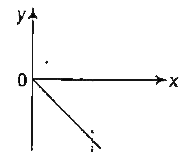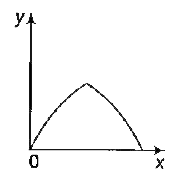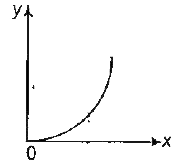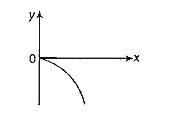Two particles of mass m and 2m have their position vectors as a function of time as r1(t)=tˆi+t3ˆj+2t2ˆkandr1(t)=tˆi+t3ˆj+t2ˆk respectively (where t is the time). Which one of the following graphs represents the path of the centre of mass?




The correct Answer is:D
Path of the centre of mass in a two particle system, r(t)=[m1r1(t)+m2r2(t)m1+m2]orr(t)=⎡⎢
⎢⎣mtˆi−t3ˆj+2t2ˆk+2m(tˆi−t3ˆj−t2ˆk)m+2m⎤⎥
⎥⎦
⇒r(t)=3tˆi−3t3ˆj3=tˆi−t3ˆj
According above result option (d ) is correct
Similar Questions
Two particles of mass m and 2m have their position vectors as a function of time as r1(t)=ˆI−t3ˆj+2t2ˆkandr2(t)=tˆi−t3ˆj−t2ˆk respectively (where t is the time). Which one of the following graphs represents the path of the centre of mass ?
View SolutionFind the shortest distance between the given line
→r=(3−t)ˆi+(4+2t)ˆj+(t−2)ˆk
→r=(1+s)ˆi+(3s−7)ˆj+(2s−2)ˆk
View Solution
Knowledge Check
The position vectors of three particles of mass m1=1kg,m2=2kgandm3=3kg are r1=(ˆi+4ˆj+ˆk)m, r2=(ˆi+ˆj+ˆk)m and r3=(2ˆi−ˆj−ˆ2k)m, respectively. Find the position vector of their center of mass.
Arcm=12(3i+j−2k)mBrcm=12(3i+2j−k)mCrcm=12(3i+3j−k)mDrcm=12(3i+j−k)mFind the area of triangle if position vector of vertices w.r.t. O is −ˆi+2ˆj+3ˆk,2ˆi−ˆj−ˆk,ˆi+ˆj−ˆk.
A√892sq.unitsB892sq.unitsC2√79sq.unitsD792sq.units
The position vectors of three particles of mass m1=1kg,m2=2kgandm3=3kg are r1=((ˆi+4ˆj+ˆk)m, r2=((ˆi+(ˆj+ˆk)m and r3=(2ˆi−(ˆj−(ˆ2k)m, respectively. Find the position vector of their center of mass.
View SolutionIf the position vector of a particle is given by →r=(cos2t)ˆi+(sin2t)ˆj+6tˆkm. Calculate magnitude of its acceleration (in m/s2 ) at t=π4
View SolutionThe position vector of a particle changes with time according to the relation →r(t)=15t2ˆi+(4−20t2)ˆj What is the magnitude of the acceleration at t = 1?
View SolutionFind the cartesian form of the equation of the plane .
¯r=(ˆi+ˆj)+s(ˆi−ˆj+2ˆk)+t(ˆi+2ˆj+ˆk)
View SolutionThe time dependence of the position of a particle of mass m = 2 is given by →r(t)=2tˆi−3t2ˆj Its angular momentum, with respect to the origin, at time t = 2 is :
View SolutionThe time dependence of the position of a particle of mass m = 2 is given by →r(t)=2tˆi−3t2ˆj Its angular momentum, with respect to the origin, at time t = 2 is :
View Solution
